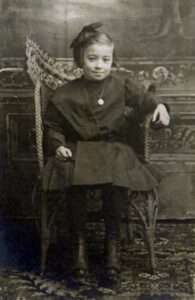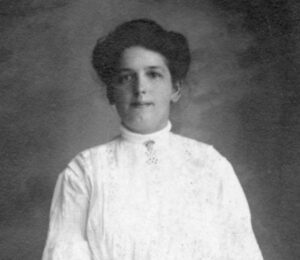More than a century ago, a horrific murder shocked the residents of Le Mars, Iowa, and the killer walked free.
Alta Marie Braun was born on Jan. 18, 1905, to Chris Braun and Lena Davis Braun in Colorado Springs, Colorado. Her father was born in Germany on Oct. 19, 1979, and came to the U.S. in 1885. Lena Braun died in Akron in 1908 when Alta was three years old.
Braun married Martha Bohlken on Dec. 7, 1910, and they had one child together, Verna Margaret Braun, in 1914. The family resided in Le Mars.
Martha Braun developed paralysis in 1916, and Alta had to take care of her sister and the household duties.
During the late summer, the circus came to town, and Alta wanted to attend.
On Aug. 24, 1917, Alta, 12, left home around 7:30 p.m. to go to her grandparents’ home on High Street on the city’s west side. Afterward, she walked a short distance to where the Yankee Robinson Circus was operating on Main and Seventh Streets. Her father had given her a dime to purchase two rides on the merry-go-round and told her to return home afterward.
Martha Braun gave Alta a quarter that afternoon, and the young girl bought some white stockings.
Several witnesses saw Alta at the merry-go-round.
According to early reports, Alta left the circus and walked to Vienna Bakery, where she purchased a five-cent sack of candy. Alta then joined Mrs. Tom Adney, walking together toward Alta’s home at Cedar and Tremont.
Adney lived on Cedar Street between Fourth and Fifth Streets. Alta parted ways with Adney around 9:30 p.m. to walk the rest of the way home and assured Adney that she was not afraid to make the trek alone.
Braun arrived home around 11 p.m. and assumed his daughter had returned from the circus and was asleep in bed. He called her for breakfast the following morning, but she did not respond. He went to her bedroom and discovered she was gone and had not slept in her bed.
Braun telephoned his father, father-in-law, and Alta’s friends, but no one had seen her. He then called the police.
At 11 a.m. on Aug. 25, 1917, a neighbor told Mrs. Herman Becker that a “dummy figure” was lying in the nearby alley. Becker lived close to Adney. Becker investigated and found Alta dead on the ground. She immediately called the authorities.
Police quickly arrived at the scene. Alta was lying on her back with her arms and legs extended and her face turned towards the north.
Le Mars Sentinel reported, “Her black underskirt had been ripped from her waist and wrapped in a toll around her throat with a tight knot under her chin.”
There were bruises on her arms and side. The killer had torn open her corset, and dust covered her limbs. Marks on the ground indicated a fierce struggle.
Alta was wearing the white stockings she had purchased the night before and had tied a nickel to her handkerchief, both found with her body.
Authorities took Alta’s body to a funeral parlor where Dr. J.M. Fettes examined it.
Dr. Fettes said Alta’s face was swollen and blueish. She had black and blue marks on her throat and arms. He and another doctor conducted a more thorough examination later and concluded she had been raped and strangled.
The investigation and hunt for the killer began.
S. B. Tingley told the police that noise had awakened him on the night of Alta’s murder. He thought it was someone running past his window. He did not hear an outcry or other sounds. Tingley lived near the railroad tracks close to where Alta’s body had laid. Outside the window, police found spilled candy which suggested that was the spot where the assailant first attacked Alta.
Police theorized that after parting with Adney, the killer grabbed Alta while she walked alone, dragged her into the alley, and raped and strangled her.
A local man named Elmer Pearson was at the circus on the night of the murder. He claimed to overhear a black man at the merry-go-round, saying he would “get” the girl before morning. However, there was a question of whether the girl was Alta.
Police learned that several black men were seen at the merry-go-round when Alta was present.
About a week after the murder, the sheriff of Carroll County arrested a black man named Edward Nelson and held him for investigation. Deputy Sheriff Jas. Sickler then transported Nelson to Sioux City and placed him in the Woodbury County jail.
Nelson admitted to working for the circus but denied killing Alta. He said he had left the job but could not remember the town’s name that he had left.
Nelson was found washing his overalls at a river near Carroll that reportedly had blood on them. However, police later determined he had been “washing off vermin from his clothing,” the Le Mars Sentinel stated.
After Nelson’s arrest, the Sioux City Journal falsely reported lynching mobs were forming in Le Mars and ready to deliver justice. However, the sheriff denied it and said deputies never took Nelson to Le Mars, and there had been no outcries for his hanging. The locals did want the police to catch Alta’s murderer and punish him, however.
Investigators brought Pearson in to identify Nelson as the man who warned he would “get” the girl, but Pearson said the man was not Nelson.
In late August 1917, another black man, Charles Smith, had been charged with the murder of a woman in Florence, Nebraska, and held in an Omaha jail. The crime was similar to Alta’s murder. However, the police could not tie him to her killing.
Ten days after his arrest, police released Nelson when they failed to find evidence proving his guilt. Investigators determined he had quit the circus in Correctionville two days after it left Le Mars and traveled to Carroll, where he was arrested for Alta’s murder.
Braun never believed Nelson killed his daughter. He testified at an inquest that two men had followed Alta and her friend a few weeks before the murder. Alta had related the scary encounter to her father. He always believed that someone local had known his daughter, was familiar with the Le Mars area, and knew when Alta would return home from the circus on the night of her killing. However, the police never investigated further or arrested any other suspects connected to the homicide. It remains unsolved today.
According to Nancy Bowers of Iowa Unsolved Murders: Historic Cases, “While preparing the body for burial, John Beely found a man’s stickpin in Alta’s clothing. Believed to have fallen there during the attack, it was the only tangible clue to the identity of the killer.”
Marth Braun died on Dec. 23, 1917, four months after Alta’s murder.
Alta’s father married Lucille Mary Weidert in 1920, and they moved to Sioux City and had six children together.
Braun worked for the Great Northern Railroad for 22 years until his retirement in 1935. That year, he lost two children and his wife to scarlet fever.
Braun later married widow Anna Sweum Molden in 1941. She had lost her husband of 37 years in 1931.
Alta’s father died on Feb. 14, 1950, in Sioux City at age 70. Anna Braun followed him in death on Oct. 4, 1967, at age 91.
Alta’s half-sister Verna Braun Gabel Williams died in California in 1991 at age 76. Her Find A Grave memorial says she was born to different parents and lists her adoptive parents. But I do not know what happened to Verna after the death of Alta and Martha Braun. It sounds like Martha Braun’s sister, Anna Bohlken Gabel, and her husband, Merton Gabel, adopted Williams after Martha Braun’s death. However, it is unclear why Chris and Lucille Braun did not raise Williams.
Suggested reading:
- “After the Merry-Go-Round: Murder of Alta Marie Braun 1917” by Nancy Bowers.
- “Alta Marie Braun” by Jody Ewing at IowaCold Cases.org.





